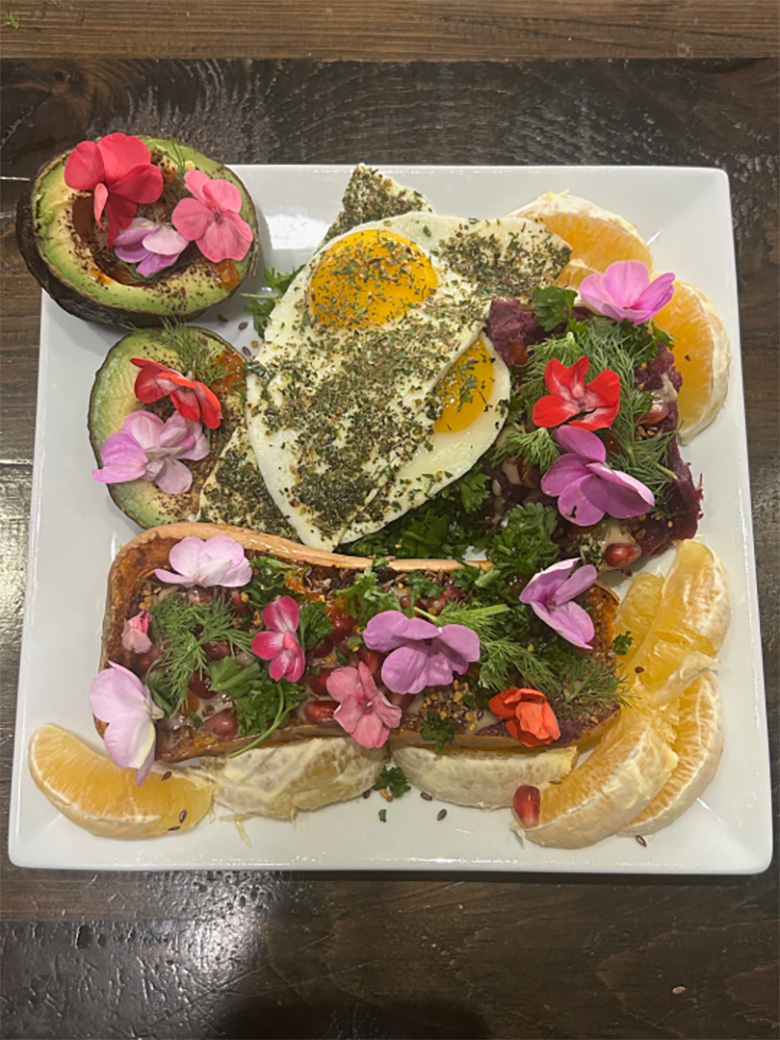My First Meal After HITEC 2024
 What is this dog’s breakfast that you see here? I’ve been reluctant to post some of the longevity meals I eat at home because my plating is certifiably atrocious, but many people have requested so here goes…
What is this dog’s breakfast that you see here? I’ve been reluctant to post some of the longevity meals I eat at home because my plating is certifiably atrocious, but many people have requested so here goes…
The idea of #foodasmedicine isn’t new, but it’s going through a huge upswing in appreciation as we start to reinforce the concept with scientific evidence. As more people start to eat healthier, they will be looking for healthier options while traveling. There’s your inspiration for paying attention.
To the image, last week saw me attend #HITEC2024 in Charlotte for a fun yet grueling and nonstop 72 hours of education sessions, exhibition floor meetups and evening events. My diet was garbage: deep fried foods, ultra-processed carbs, seed oil-based sauces, too much alcohol (especially types of beer containing phytoestrogens), too much caffeine late in the day, refined sugar hits to stay fully coherent during back-to-back-to-back booth meetings, and horrible sleep in between.
Below was my first meal once back in Toronto, a late breakfast at 11am representing one of two meals I ate that day to get back into a consistent 8:16 intermittent fasting rhythm.
A few overall thoughts first:
- Eat the rainbow. The different colors in foods are made by pigments, of which most have some research pointing to their therapeutic effects as well as their synergistic benefits when consumed alongside other pigments in other foods – what is often called ‘nature’s symphony’. Hence, you want your plate to be as vibrant as possible.
- Opportunistic omnivores. – TRIGGER WARNING – from all the longevity research I’ve read, the evidence increasingly points to optimal nutrition requiring both plants and animal food courses. Veganism and full carnivorism are not paths to longevity. Humans are the craftiest of scavengers and persistent hunters; we need balance. One thing that’s certain, though, is that our bodies don’t really handle CAFO (caged animal feeding operation) animal products all that well. This deserves a whole other post, so just ensure that all animal food sources are clean (wild-caught fish, pasture-raised eggs, grass-fed dairy, grass-finished beef etc).
- Yes, I’m a bit crazy…but people are changing the way they eat and if this style of ‘longevity cuisine’ catches on, then you’re going to need to pivot your F&B accordingly…
Now let’s go through the image clockwise:
AVOCADOS: A health staple packed with oleic acid, the studied longevity mono-unsaturated fatty acid (MUFA) also found in olive oil as well as loads of fiber. Rather than just plain avo, I sprinkle lots of spices on mine; for this particular meal it’s lemon-tasting, red-pigmented sumac. The flowers on top are busy lizzies, homegrown in my indoor smart garden; edible flowers in general are a fantastic way to get a bit more pigment into your meals without adding a lot of calories.
EGGS: Two pasture-raised and lightly cooked to not denature the omega 3s, lutein, cholesterol and vitamin A in the yolks. Then lathered in dried herbs…all my eggs end up looking like a Jackson Pollack…
PURPLE SWEET POTATOES: A hallmark of the traditional Okinawan diet, they’re super high in anthocyanins, and I augment the fiber content by cooking then eating them cold (a process called starch retrogradation). On top of these are some pomegranates for some more red pigment and its ellagic acid (a critical prebiotic for making Urolithin A to boost mitochondrial function) as well as multiple handfuls of chopped dill and parsley – the latter herb being a weekly staple for its apigenin and pyrroloquinoline quinone (PQQ) content, two proven longevity molecules.
ORANGES: Organic which makes them far more flavorful in my opinion. Also, through the principle of hormesis, organic boosts this fruit’s flavonoid content while, of course, minimizing pesticide and herbicide exposure. Always, always eat organic wherever possible.
BUTTERNUT SQUASH: A whole half that I roast with curry spice blend (turmeric, black pepper, cumin and others) and paprika, and doused in more dill and some fermented hot sauce. This one was organic so I could safely eat the skin, and like the sweet potato, I cooled it first to activate the retrograde starches for increased fiber content.
You may think that this is too high in carbs and not enough protein. Both are true, but I’m eating it in the morning, so enough time to ‘work off’ the carbs through exercise that afternoon and full digestion before bedtime. Next, these are ‘good carbs’ as in natural, high in fibers and oligosaccharides, and colorful food matrixes, helping buffer or blunt sugar spikes.
As well, like how hard it is to clean the dishes with cold water versus hot, I wouldn’t advocate for eating cold starches later in the evening because it would slow down digestion too much in the hours before sleep. Second, this is one of two meals eaten that day; dinner happened to be a big portion of wild-caught sockeye salmon (very high in astaxanthin) with green vegetables…keto friendly and hitting my daily requirement for protein intake.
I hope this post was inspiring. Even with all the holidays and barbecues coming up, try to be healthier back at home by eating clean, whole foods with lots of herbs, spices and color.
(Originally as a LinkedIn article by Adam Mogelonsky posted on June 30, 2024)